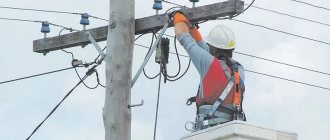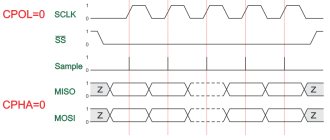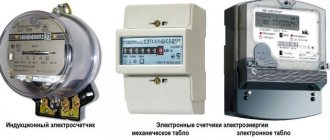Converter
To calculate the values, you can use an easy-to-use converter. Converter is a system that converts source data into a given value. All the user needs to do is paste the available data into the field and press the start button on the service being used.
Note! There are different system converters. Some convert these watts, and some directly into kilowatts.
Convector
How to correctly convert these units
A watt is equal to a kilogram multiplied by square meters and divided by cubic seconds. The prefix kilo denotes multiplication by 1000. The same principle applies to power indicators, that is, 1 kW contains 1000 W and 1000 volts. This means that 1 unit = 0.001 subunits. That is, if you convert the power, then a 3 kW electrical appliance will be equal to 3000 W.
You may be interested in this Definition of plus and minus in electrical engineering
Conversion formula
In electricity
To simplify measurements in electricity, a subunit is used. You can find out how many watts are in a kilowatt and convert the units by multiplying watts by 103 and dividing by 1000. To carry out the reverse conversion, you need to multiply kW by 103 or multiply known indicators by 1000.
Quantities in electricity
In heating
To measure thermal power, you need to use the joule. This is the work done by 1 newton per 1 meter. To convert joule to kW, you need to use the joule subunit. There are 0.239 kcal in 1 kJ. There are 4.1868 kJ in 1 kcal. There are 860 kcal in 1 kW. This means that 1000 kcal contains 1.163 kW per hour.
Heating measurements
Electric potential
A charge introduced into an electric field has a certain amount of energy, i.e., the ability to do work. To characterize the energy stored at each point of the electric field, a special concept was introduced - electric potential. The potential of the electric field at a given point is equal to the work that the forces of this field can do when moving a unit of positive charge from this point outside the field.
Returning to the analogy with the gravitational field, we can find that the concept of electric potential is akin to the concept of the level of various points on the earth's surface. That is, as we will consider below, the work of raising a body above sea level depends on how high we raise that body, and similarly, the work of moving one charge away from another depends on how far these charges are.
Let's imagine the hero of the ancient Greek world, Sisyphus. For his sins in earthly life, the gods sentenced Sisyphus to do hard, meaningless work in the afterlife, rolling a huge stone to the top of a mountain. Obviously, to lift a stone halfway up the mountain, Sisyphus needs to spend half as much work as to lift the stone to the top. Then the stone, by the will of the gods, rolled down the mountain, doing some work. Naturally, a stone raised to the top of a mountain of height H
(level H), when descending, will be able to do more work than a stone raised to level
H
/2. Sea level is generally considered to be the zero level, from which altitude is measured.
By analogy, the electrical potential of the earth's surface is considered zero potential, that is
ϕEarth = 0
where ϕEarth is the designation of the Earth’s electrical potential, which is a scalar quantity (ϕ is a letter of the Greek alphabet and is read as “phi”).
This quantity quantitatively characterizes the field’s ability to do work (W) to move some charge (q) from a given point in the field to another point:
ϕ = W/q
The SI unit of electrical potential is the volt (V).
Visitors to the Canadian Science and Technology Museum spin a large squirrel wheel, which spins a generator that powers a Tesla transformer (pictured right), which in turn creates a high voltage of several tens of thousands of volts, enough to puncture the air.
Electricity voltage level
The tariff or calculated voltage level plays a critical role in determining the cost of electricity and power for consumers. What is a physical voltage level in general, and what is a voltage level determined for the purposes of applying electricity tariffs? Let's try to figure it out in this article.
Electrical energy generated at large power plants by generators (nuclear power plants, hydroelectric power plants, thermal power plants) is supplied to high, ultra-high or ultra-high voltage electrical networks - 110, 220, 330, 500, 750 or even 1150 kV (kilovolts). Further, through such electrical networks, electrical energy is transmitted over considerable distances to step-down substations. The principle of transmitting electrical energy using electrical networks of high and ultra-high voltage levels makes it possible to significantly reduce losses of electrical energy when transmitting it over long distances.
Typically, consumer power receivers are connected to medium and low voltage electrical networks. However, often many large production facilities (factories, etc.) are connected to high-voltage electrical networks and such consumers have on their balance sheet their own electrical grid facilities (substations) that reduce the voltage level.
As we have repeatedly mentioned on our website, the final electricity tariff for enterprises consists of several components. Due to the fact that the voltage level can change during the production and transmission of electrical energy to the consumer, the component of the final price for electricity for enterprises - the tariff for services for the transmission of electrical energy also changes depending on the voltage level at which the consumer is connected to the electrical networks. A component of the final price for electricity - the tariff for transmission services is at least 40% of the final tariff for electricity for the enterprise. Therefore, correctly determining the calculated voltage level is a very important point for making correct calculations with electricity suppliers.
There are several tariff levels of electricity voltage:
- GN voltage level
- Voltage level VN1
- HV voltage level
- Voltage level CH1
- CH2 voltage level
- LV voltage level
The higher the calculated voltage level of the consumer, the lower the tariff applied by the electricity supplier for the provision of services for the transmission of electrical energy to calculate the cost of electrical energy and power supplied to such a consumer.
Consequently, the higher the voltage level at the point of connection the consumer has, the lower his further costs for paying electricity to suppliers will be!
Therefore, correct determination of the voltage level plays an important role for any consumer.
Initially, the calculated (tariff) voltage level is determined in the act of delimiting the balance sheet of the parties, which is drawn up by the network company after the completion of the procedure for technological connection to electric networks. Then, the tariff voltage level is translated into an energy supply contract between the consumer and the electricity supplier.
In this regard, in relation to new facilities that have not yet been connected to the electrical network, before submitting an application for technological connection to the electrical network company and signing an agreement on technological connection to electrical networks, it is necessary to carefully calculate all possible consequences for choosing the point of connection to electrical networks, as well as the procedure for fulfilling technical conditions for connecting to electric grids (at whose expense will the construction be carried out and who will remain the owner of the electric grid facilities after connection). The applicable tariff voltage level and, accordingly, the cost of electricity will depend on this.
In addition, it is worth noting the importance of correctly reflecting the calculated voltage level in the energy supply agreement concluded between the consumer and the electricity supplier. If the tariff voltage level in the energy supply contract is agreed upon incorrectly, then achieving a recalculation of the cost of consumed electricity for previous periods will be very problematic for the consumer. However, our company has extensive experience in defending violated consumer rights. We are ready to take on the problem of using an incorrect tariff voltage level and return the overpayment for previous years to the consumer.
That is why, the cost of electrical energy for your enterprise, company or organization will depend on how correctly you can submit an application for connection to electrical networks and conclude an energy supply agreement with an energy retailer.
Voltage characteristics
Voltage is characterized by its magnitude and shape. Regarding its behavior over time, a distinction is made between constant voltage (not changing over time), aperiodic voltage (changing over time) and alternating voltage (changing over time according to a certain law and, as a rule, repeating itself after a certain period of time). Sometimes, to achieve certain goals, the simultaneous presence of direct and alternating voltages is required. In this case, we talk about alternating current voltage with a constant component.
This voltmeter was used to measure voltage at the beginning of the 20th century. Canadian Science and Technology Museum in Ottawa
In electrical engineering, DC generators (dynamos) are used to create a relatively stable high-power voltage; in electronics, precision DC voltage sources are used on electronic components, which are called stabilizers
.











